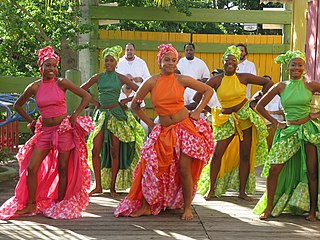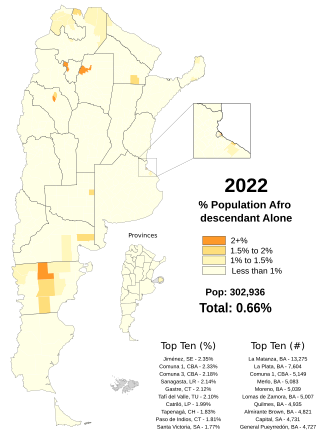An African American is a citizen or resident of the United States who has origins in any of the black populations of Africa. African American-related topics include:

Candombe is a style of music and dance that originated in Uruguay among the descendants of liberated African slaves. In 2009, the United Nations Educational, Scientific and Cultural Organization (UNESCO) inscribed candombe in its Representative List of the Intangible Cultural Heritage of Humanity.

In the context of the history of slavery in the Americas, free people of color were primarily people of mixed African, European, and Native American descent who were not enslaved. However, the term also applied to people born free who were primarily of black African descent with little mixture. They were a distinct group of free people of color in the French colonies, including Louisiana and in settlements on Caribbean islands, such as Saint-Domingue (Haiti), St. Lucia, Dominica, Guadeloupe, and Martinique. In these territories and major cities, particularly New Orleans, and those cities held by the Spanish, a substantial third class of primarily mixed-race, free people developed. These colonial societies classified mixed-race people in a variety of ways, generally related to visible features and to the proportion of African ancestry. Racial classifications were numerous in Latin America.
Afro–Latin Americans or Black Latin Americans are Latin Americans of full or mainly sub-Saharan African ancestry.

Black Peruvians or Afro-Peruvians are Peruvians of mostly or partially African descent. They mostly descend from enslaved Africans brought to Peru after the arrival of the conquistadors.
Afro-Dominicans are Dominicans of predominant or full Black African ancestry. Approximately 7.9 million people in the Dominican Republic are of African descent, However due to the Dictatorship of Rafael Trujillo, most Dominicans refuse to identify as black and deny their African heritage, those who do identify as black are a minority in the country representing 7.8% of the population, according to a census bureau survey in 2022. About 4.0% of the people surveyed claim an Afro-Caribbean immigrant background, while only 0.2% acknowledged Haitian descent. Currently there are many black illegal immigrants from Haiti, who are not included within the Afro-Dominican demographics as they are not legal citizens of the nation.

Africanisms refers to characteristics of African culture that can be traced through societal practices and institutions of the African diaspora. Throughout history, the dispersed descendants of Africans have retained many forms of their ancestral African culture. Also, common throughout history is the misunderstanding of these remittances and their meanings. The term usually refers to the cultural and linguistic practices of West and Central Africans who were transported to the Americas during the trans-Atlantic slave trade. Africanisms have influenced the cultures of diverse countries in North and South America and the Caribbean through language, music, dance, food, animal husbandry, medicine, and folklore.

Afro–Puerto Ricans are Puerto Ricans who are of African descent. The history of Puerto Ricans of African descent begins with free African men, known as libertos, who accompanied the Spanish Conquistadors in the invasion of the island. The Spaniards enslaved the Taínos, many of whom died as a result of new infectious diseases and the Spaniards' oppressive colonization efforts. Spain's royal government needed laborers and began to rely on African slavery to staff their mining and fort-building operations. The Crown authorized importing enslaved West Africans. As a result, the majority of the African peoples who entered Puerto Rico were the result of the Atlantic slave trade, and came from many different cultures and peoples of the African continent.

Fort Mose, originally known as Gracia Real de Santa Teresa de Mose, and later as Fort Mose, or alternatively, Fort Moosa or Fort Mossa, is a former Spanish fort in St. Augustine, Florida. In 1738, the governor of Spanish Florida, Manuel de Montiano, had the fort established as a free black settlement, the first to be legally sanctioned in what would become the territory of the United States. It was designated a US National Historic Landmark on October 12, 1994.

Afro-Argentines, are Argentines who have predominantly or total Sub-Saharan African ancestry. The Afro-Argentine population is the result of people being brought over during the transatlantic slave trade during the centuries of Spanish domination in the region and immigration from Africa.

In the American Revolution, gaining freedom was the strongest motive for Black enslaved people who joined the Patriot or British armies. It is estimated that 20,000 African Americans joined the British cause, which promised freedom to enslaved people, as Black Loyalists. Around 9,000 African Americans became Black Patriots.

Afro-Bolivians are Bolivian people of Sub-Saharan African heritage and therefore the descriptive "Afro-Bolivian" may refer to historical or cultural elements in Bolivia thought to emanate from their community. It can also refer to the combining of African and other cultural elements found in Bolivian society such as religion, music, language, the arts, and class culture. The Afro-Bolivians are recognized as one of the constituent ethnic groups of Bolivia by the country's government, and are ceremonially led by a king who traces his descent back to a line of monarchs that reigned in Africa during the medieval period. They numbered 23,000 according to the 2012 census.

Afro-Panamanians are Panamanians of African descent. The Afro-Panamanian population can be mainly broken into one of two categories "Afro-Colonials", Afro-Panamanians descended from slaves brought to Panama during the colonial period, and "Afro-Antilleans", West Indian immigrant-descendants with origins in Trinidad, Martinique, Saint Lucia, Guadeloupe, Dominica, Grenada, Haiti, Belize, Barbados, and Jamaica, whose ancestors were brought in to build the Panama Canal. Afro-Panamanians can be found in the towns and cities of Colón, Cristóbal and Balboa, the Río Abajo area of Panama City, the Canal Zone and the province of Bocas del Toro.

Afro-Chileans are Chilean people of African descent. They may be descendants of slaves who were brought to Chile via the trans-Atlantic slave trade, or recent migrants from other parts of Latin America, the Caribbean or Africa.

Afro-Mexicans, also known as Black Mexicans, are Mexicans who have heritage from sub-Saharan Africa and identify as such. As a single population, Afro-Mexicans include individuals descended from both free and enslaved Africans who arrived to Mexico during the colonial era, as well as post-independence migrants. This population includes Afro-descended people from neighboring English, French, and Spanish-speaking countries of the Caribbean and Central America, descendants of enslaved Africans in Mexico and those from the Deep South during Slavery in the United States, and to a lesser extent recent migrants directly from Africa. Today, there are localized communities in Mexico with significant although not predominant African ancestry. These are mostly concentrated in specific communities, including the populations of the Oaxaca, Huetamo, Lázaro Cárdenas, Guerrero, and Veracruz states.

Afro-Venezuelans are Venezuelans of African descent. Afro-Venezuelans are mostly descendants of enslaved Africans brought to the Western Hemisphere during the Atlantic slave trade. This term also sometimes refers to the combining of African and other cultural elements found in Venezuelan society such as the arts, traditions, music, religion, race, and language.

Afro Salvadorans are Salvadorans of Sub-Saharan African descent. They are the descendants of slaves brought to El Salvador via the Trans-atlantic slave trade during the colonial Spanish era.

Afro-Hondurans or Black Hondurans are Hondurans of Sub-Saharan African descent. Research by Henry Louis Gates and other sources regards their population to be around 1-2%. They descended from: enslaved Africans by the Spanish, as well as those who were enslaved from the West Indies and identify as Creole peoples, and the Garifuna who descend from exiled zambo Maroons from Saint Vincent. The Creole people were originally from Jamaica and other Caribbean islands, while the Garifuna people were originally from Saint Vincent and the Grenadines. Garifunas arrived in the late seventeen hundreds and the Creole peoples arrived during the eighteen hundreds. About 600,000 Hondurans are of Garífuna descent that are a mix of African and indigenous as of Afro Latin Americans. Honduras has one of the largest African community in Latin America.

Afro-Paraguayans are Paraguayans of African descent. They can be found in Camba Cua outside Asuncion; Kamba Kokue outside Paraguari, and the city of Emboscada.


















